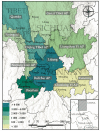What Was George Forrest's Plant Collection Journey like in China?
- PMID: 38794438
- PMCID: PMC11125649
- DOI: 10.3390/plants13101367
What Was George Forrest's Plant Collection Journey like in China?
Abstract
Since the 16th century, Western countries have conducted extensive plant collections in Asia, particularly in China, driven by the need to collect botanical resources and foster academic development. These activities have not only significantly enriched the Western botanical specimen collections but have also had a profound impact on the development of related disciplines such as botany, ecology, and horticulture. During this process, a large number of renowned plant hunters emerged, whose discoveries and contributions are still remembered today. George Forrest (1873-1932) was one of these distinguished plant hunters. From 1904 to 1932, he visited China seven times to collect plants and became famous for the regional distinctiveness of the species he collected. However, due to the lack of systematic collection, organization, and analysis of specimens collected by Forrest, only a few species, such as the species Rhododendron, are well-known among the many species he introduced to the West. Furthermore, the personal collecting characteristics and the characteristic species collected by Forrest are also not clear. This limits a comprehensive understanding of the specimen collection history and impact of Forrest in China. Therefore, systematic organization and analysis of Forrest's plant specimens collected in China are crucial to understanding his impact on botanical classification, Rhododendrons introduction, global horticulture, and plant propagation. This study aims to systematically organize and analyze the plant specimens collected by George Forrest in China to investigate the family, genus, and species composition of the collected specimens and the seven collection expeditions of Forrest in China, as well as the time and altitude of these collections. Furthermore, it seeks to discuss Forrest's scientific contributions to the global spread of plants, the widespread application of the Rhododendron, and his impact on the development of modern gardens, providing a theoretical basis and data reference for related research and professional development. To this end, we extensively consulted important historical literature related to Forrest and systematically collected data from online specimen databases. The conclusions drawn from the available data include 38,603 specimens, with 26,079 collection numbers, belonging to 233 families, 1395 genera, and 5426 species, which account for 48.24%, 32.63%, and 14.17% of the plant families, genera, and species in China, respectively. Rhododendron specimens made up 17.20% of the specimens collected in this study. The collection locations cover three provinces or autonomous regions, 11 prefecture-level cities, and 25 counties. Furthermore, we found that Forrest's collections were concentrated in spring and summer, mainly in high-altitude areas, with 135 species found below 1500 m and 3754 species at 1500 m and above. Rhododendron specimens were mostly found above 3000 m.
Keywords: Rhododendron; ethnobotany; plant collection history; specimen collection.
Conflict of interest statement
The authors declare no conflicts of interest.
Figures







References
-
- Lv L.Y., Zhao Y., Yu G.Q. Historical status and trends of grassland plant resource surveys at home and abroad. Heilongjiang Anim. Husb. Vet. Med. 2016;10:140–143.
-
- Liu L. The dissemination and influence of texts by Westerners in China accounting for environmental changes in China in modern times. J. Beijing For. Univ. (Soc. Sci. Ed.) 2015;14:1–7.
-
- Svanberg I., Hällzon P., Ståhlberg S. Glimpses of Loptuq folk botany: Phytonyms and plant knowledge in Sven Hedin’s herbarium notes from the Lower Tarim River area as a source for ethnobiological research. Stud. Orient. Electron. 2019;7:96–119. doi: 10.23993/store.76475. - DOI
LinkOut - more resources
Full Text Sources

